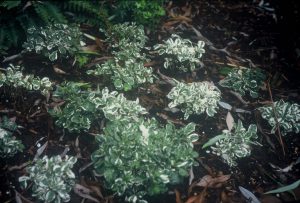
Ajuga ‘Vanilla Chip’ in deep shade
As I mentioned last week, now is a great time to start thinking about changes you want to make in your garden. You can still see the ground and the dormant plants, assuming that you did not cut everything down.
This week, I am continuing the discussion by featuring perennials with variegated foliage. There are so many that this discussion will probably consume this post and another one next week.
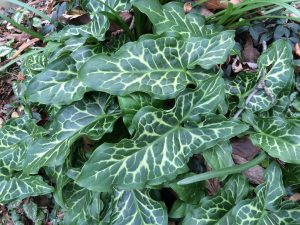
Arum italicum ‘Pictum’
To begin, I have to mention one of my favorites, Arum italicum ‘Pictum’ (Variegated Italian Arum), with its unusual life cycle. It has beautiful leaves, a different flower, and fantastic fruit. It is a clumper that increases slowly. It’s definitely hardy to zone 6 and probably to zone 5.
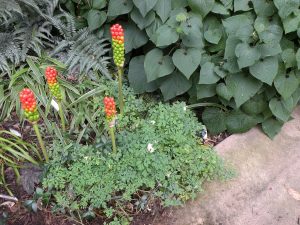
Arum italicum ‘Pictum’ berries
Let’s start with the life cycle. Unlike most herbaceous plants, Arum italicum foliates in early fall. The leaves are quite visible during the winter (unless covered by snow) and spring. In May, a creamy-yellow spadix cupped by a spathe of green, quite similar to that of Arisaema triphyllum (Jack-in-the-Pulpit), appears. After flowering, the leaves disappear, leaving only the flowering stalk which is relatively inconspicuous. Do not deadhead the spadix or you will miss the show. Gradually, the stalk develops large green berries. Then, suddenly, in late July and early August, there is an orange-red, large berried “stick”. Normally, the berries last well into the fall but unknown creatures that inhabit my garden have been surreptitiously eating the berries, leaving only a yellow stick. I may have to surround the berries with chicken wire!
The leaves are large and triangular. There are several cultivars with mottled, spotted or white-veined foliage. I am a great fan of the cultivars with white veins because they illuminate the shade and provide contrast to those plants with green foliage.
Arum italicum ‘Pictum’ is a tuber that can be planted in fall or spring. It grows in partial to full shade in moist soil. With sufficient moisture, the stalks can grow 20” high but in my garden, it generally grows 12” high. This is an excellent plant to use with Hosta because the Arum leaves disappear just when the Hosta leaves are finally foliating.
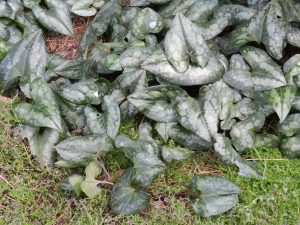
Asarum splendens
Asarum splendens (Chinese Wild Ginger) never goes dormant; it is, in fact, evergreen and rhizomatous. Its semi-shiny, arrow-shaped, somewhat small leaves rarely grow taller than 6” and have silvery mottling. The dark purple, spring-blooming flowers hide in the leaves so are hard to see. That’s not a bad thing because, frankly, I think the flowers are ugly. Hardy to zone 5, this is another shade perennial that prefers moist soil but will survive quite well in drier sites.

Polygonatum odoratum ‘Variegatum’
A third variegated perennial for shade is Polygonatum odoratum ‘Variegatum’ (Variegated Solomon’s Seal). It was the Perennial Plant Association 2013 Plant of the Year. This all-season perennial provides interest for the entire growing season. It has small, creamy white bells that dangle from the leaf nodes of arching, unbranched stems,.variegated foliage that turns golden yellow in the fall, and small blue-black fruits that are charming but not spectacular. It requires at least partial shade and will tolerate heavy shade.
Hardy in zones 3-8, Polygonatum odoratum ‘Variegatum’ grows twenty-four to thirty-six inches tall. It is rhizomatous and forms colonies within a few years if ample moisture is supplied.
Division will not be necessary for many years but I would plant at least three, spacing them a foot apart, since spread is slow.
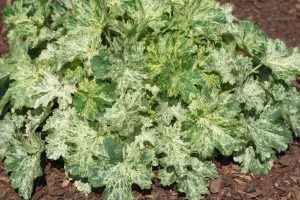
Heuchera ‘Snow Angel’-footprintsplants.com
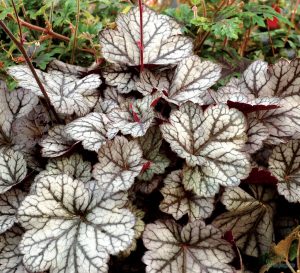
Heuchera ‘Glitter’-plantagogo.com
Last but not least of the variegated perennials for shade is Heuchera (Alum Root), hardy to zone 4. There are several cultivars, among them ‘Snow Angel’ (green sprinkled with white) and ‘Glitter’ (silver with dark veins). Morning sun is fine for these cultivars but afternoon sun will scorch them. Provide plenty of moisture for best success.
Almost everyone has shade so I know you will want to find spaces for some of these lovely perennials.


0 Comments